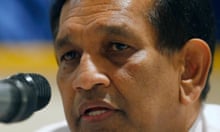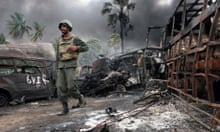1975: The Liberation Tigers of Tamil Eelam group forms, demanding a separate state for ethnic-minority Tamils in the island's north and east.
1983: Civil war begins.
1991: A Tamil Tiger suicide bomber assassinates the Indian prime minister, Rajiv Gandhi, apparently in revenge for sending Indian peacekeeping troops who ended up fighting the rebels.
1993: Another Tamil Tiger suicide bomber kills Sri Lanka's president, Ranasinghe Premadasa, after failed peace efforts.
February 2002: The Sri Lankan government signs a ceasefire with the Tamil Tigers.
June 2005: Relations between the government and rebels deteriorate over sharing international tsunami aid.
August 2005: Assassination of the foreign minister, Lakshman Kadirgamar, an ethnic Tamil who opposed a separate state for the minority. Tigers are blamed.
December 2005: Rebels launch their first major attack since the 2002 truce, killing a dozen Sri Lankan sailors. A series of attacks follow.
22 February 2006: Government and rebel officials meet in Switzerland for peace talks and agree to reduce violence. A second round of talks scheduled for a few months later is postponed as the two sides argue over transport and security.
8 June 2006: Collapse of talks in Norway aimed at restoring peace.
20 July 2006: The Tamil Tigers close the sluice gates of an eastern reservoir, cutting water to more than 60,000 people, prompting the government to launch its first major offensive on Tiger territory since the 2002 ceasefire.
2 November 2007: A government air raid kills the Tamil Tigers' political boss, SP Thamilselvan, believed to be second-in-command.
2 January 2008: The government says the Tamil Tigers must disarm before peace talks.
16 January 2008: Sri Lanka's ceasefire is officially terminated.
29 August 2008: Sri Lanka urges civilians living in rebel-held areas to flee to government-run territory.
2 January 2009: The military says Sri Lankan forces have entered the guerrillas' de facto capital, Kilinochchi, predicting it will fall within hours.
11 January 2009: An article by Lasantha Wickrematunge, one of Sri Lanka's best-known journalists, is posthumously published in which he foresees his own murder by the government.
5 February 2009: Sri Lanka snubs the international community's call for a ceasefire, saying troops will not suspend their offensive against Tamil Tiger rebels.
10 February 2009: The Red Cross evacuates 240 sick and wounded people by boat from the north-east war zone as the military accuses rebel fighters of killing 19 civilians fleeing the area.
13 February 2009: Sri Lanka accuses Britain of meddling after Gordon Brown appoints the former defence secretary Des Browne as a special envoy to the country.
20 February 2009: Two Tamil Tiger aircraft launch a surprise raid on Colombo, hitting a tax building and injuring at least 27 people. Sri Lankan jets shoot down one aircraft.
23 February 2009: Tamil Tiger rebels tell the UN and the international community they are willing to accept a ceasefire but reject calls to lay down arms and surrender. The Sri Lankan government rejects the offer.
7 April 2009: Sri Lanka rejects a call by the UN for a ceasefire.
21 April 2009: Unicef says it faces a "human avalanche" of civilians fleeing the conflict. Sri Lanka gives the rebels 24 hours to surrender.
24 April 2009: The United Nations says nearly 6,500 civilians have been killed and 14,000 wounded in three months of offensive against the Tigers.
26 April 2009: Tigers declare unilateral ceasefire. Sri Lanka calls it "a joke" and says LTTE must surrender.
16 May 2009: The army seeks to destroy the last pocket of Tamil fighters in defiance of international pleas for a halt to the fighting and accusations from the UN that they had triggered a bloodbath. President Mahinda Rajapaksa, at a meeting of developing nations in Jordan, says the LTTE has been defeated militarily, even as fighting rages.
17 May 2009: More than 70 LTTE fighters are killed trying to flee by boat. Many more blow themselves up in suicide attacks as the army battles to finish them off. Military declares all civilians freed; says number in excess of 72,000 over four days. Rebels say the war has reached the "bitter end".
18 May 2009: The Sri Lankan government formally declares an end to the 25-year civil war after the army took control of the entire island and killed the Tamil Tigers' rebel leader, Velupillai Prabhakaran.



